
Home - Search - Browse - Alphabetic Index: 0- 1- 2- 3- 4- 5- 6- 7- 8- 9
A- B- C- D- E- F- G- H- I- J- K- L- M- N- O- P- Q- R- S- T- U- V- W- X- Y- Z
Venera 4V-1
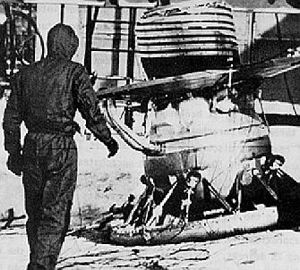 Venera 9 lander test Venera 9 lander in test Credit: NASA |
AKA: 4V;4V-1. Status: Operational 1975. First Launch: 1975-06-08. Last Launch: 1981-11-04. Number: 6 . Gross mass: 5,030 kg (11,080 lb).
The Venera 4V models were the first of the series designed by the new chief designer of NPO Lavochkin, Vyaseslav Mikhailovich Kovtunenko, who had earlier worked at KB Yuzhnoye for many years. They became very successful combination Venus lander / Venus flyby spacecraft. After launch and a three to five month coast to Venus, the descent vehicle separated from the bus and plunged into the Venus atmosphere two days later. As it flew by Venus the bus acted as a data relay for the brief life of the descent vehicle, and then continued into a heliocentric orbit.
The bus was equipped with instrumentation including a gamma-ray spectrometer, retarding potential traps, UV grating monochromator, electron and proton spectrometers, gamma-ray burst detectors, solar wind plasma detectors, and two-frequency transmitters which made measurements before, during, and after the Venus flyby. These instruments studied solar-wind composition, gamma-ray bursts, ultraviolet radiation, and the electron density of the ionosphere of Venus. Instruments carried on other missions included a French 3500 angstrom UV photometer, a 4000-7000 angstrom photo-polarimeter, a 1.5 to 3 micron infrared spectrometer, and a 8 - 30 micron infrared radiometer, and a magnetometer . The orbiter consisted of a cylinder with two solar panel wings and a high gain parabolic antenna attached to the curved surface. A bell-shaped unit holding propulsion systems was attached to the bottom of the cylinder, and mounted on top was a 2.4 meter sphere which held the lander.
The descent craft/lander was a hermetically sealed pressure vessel, which contained most of the instrumentation and electronics, mounted on a ring-shaped landing platform and topped by an antenna. The descent craft included a system of circulating fluid to distribute the heat load. This system, plus precooling prior to entry, permitted operation of the spacecraft for 32 minutes after landing (although up to two hours were actually achieved). During descent, heat dissipation and deceleration were accomplished sequentially by protective hemispheric shells, three parachutes, a disk-shaped drag brake, and a compressible, metal, doughnut-shaped, landing cushion. The descent craft carried instruments designed to study the detailed chemical composition of the atmosphere, the nature of the clouds, and the thermal balance of the atmosphere. Among the instruments on board was a gas chromatograph to measure the composition of the Venus atmosphere, instruments to study scattered solar radiation and soil composition, and a device named Groza which was designed to measure atmospheric electrical discharges. The spacecraft usually carried a camera system, and later versions included an X-ray fluorescence spectrometer, a screw drill and surface sampler, a dynamic penetrometer, and a seismometer to conduct investigations on the surface.
NASA NSSDC Master Catalog Description
The Venera 9 descent craft/lander was attached on top of an orbiter at launch. Venera 9 and 10 were a pair of identical spacecraft prepared for the June 1975 launch opportunity. The scientific objectives of the descent craft/lander were to make in-situ measurements in the Venus atmosphere and on the surface. Venera 9 transmitted images of the Venus surface, the first images ever sent back from the surface of another planet.
Spacecraft and Subsystems
The descent craft/lander comprised a spherical body mounted by a series of struts on a toroidal landing platform and topped by a disk (the titanium aerobrake) and a cylindrical tower. The full entry probe, which included a 2.4 m aluminum heat shield and held the descent craft, had a mass of 1560 kg. The lander was 2 m high and had a mass of 660 kg. Data transmission would be at 256 bits/sec, through a helical antenna wrapped around the upper cylinder using the orbiter as a relay. It carried a panoramic imaging system mounted 90 cm above the base, a thermometer, barometer, anemometer, mass spectrometer, photometers, nephelometer, gamma-ray spectrometer, radiation densitometer, and accelerometers.
Mission Profile
Venera 9 was launched on 8 June 1975 at 02:38:00 UT on a Proton booster. There were two mid-course corrections en-route to Venus, on 16 June and 15 October. On October 20, 1975, the descent craft was separated from the Orbiter, and landing was made at 05:13 UT on October 22. A system of circulating fluid was used to pre-cool the lander to -10 C and distribute the heat load. This system permitted operation of the spacecraft for 53 min after landing. During descent, heat dissipation and deceleration were accomplished sequentially by a protective hemispheric aeroshell heat shield (released at 64 km altitude), three parachutes (jettisoned at 50 km), the disk-shaped drag brake, and a compressible, metal, doughnut-shaped, landing cushion which absorbed the shock of the 7 m/sec impact and held many of the instruments. The landing was at 31.7 N, 291 E, near Beta Regio, about 2,200 km from the Venera 10 landing site. The panoramic imaging system could only take a 180 degree image instead of the planned 360-degree panorama because one of the two covers failed to release.
Preliminary results indicated: (A) clouds 30-40 km thick with bases at 30-35 km altitude, (B) atmospheric constituents including HCl, HF, Br, and I, (C) surface pressure about 90 (earth) atmospheres, (D) surface temperature 485 deg C, (E) light levels comparable to those at earth midlatitudes on a cloudy summer day, and (F) successful TV photography showing shadows, no apparent dust in the air, and a variety of 30-40 cm rocks which were not eroded.
NASA NSSDC Master Catalog Description
Venera 13 and 14 were identical spacecraft built to take advantage of the 1981 Venus launch opportunity. Launched 5 days apart, the objective of the missions was to make in-situ studies of the Venus atmosphere and surface.
Spacecraft and Subsystems
The Venera 13 mission consisted of a bus (81-106A) and an attached descent craft (81-106D). The Venera 13 descent craft/lander was a hermetically sealed pressure vessel, which contained most of the instrumentation and electronics, mounted on a ring-shaped landing platform and topped by an aerobraking disc and a cylindrical antenna. The design was similar to the earlier Venera 9-12 landers. Mass of the lander was 760 kg. It carried instruments to take chemical and isotopic measurements, monitor the spectrum of scattered sunlight, and record electric discharges during its descent phase through the Venusian atmosphere. The spacecraft utilized a camera system (with red, green, blue, and clear filters), an X-ray fluorescence spectrometer, a screw drill and surface sampler, a dynamic penetrometer, an acoustic detector, and a seismometer to conduct investigations on the surface.
Mission Profile
After launch on 30 October 1981 at 06:04 UT and a four month cruise to Venus involving two midcourse corrections (10 November 1981 and 21 February 1982), the descent vehicle separated from the bus and plunged into the Venus atmosphere on 1 March 1982. The parachute was deployed at 63 km altitude. At an altitude of 47 km the parachute was released and simple airbraking was used the rest of the way to the surface. The descent lasted about an hour. Venera 13 landed at 03:57:21 UT at 7.5 S, 303 E, just east of the eastern extension of an elevated region known as Phoebe Regio. The area was composed of bedrock outcrops surrounded by dark, fine-grained soil. After landing an imaging panorama was started and a mechanical drilling arm reached to the surface and obtained a sample, which was deposited in a hermetically sealed chamber, maintained at 30 degrees C and a pressure of about .05 atmospheres. The lander survived for 127 minutes (the planned design life was 32 minutes) in an environment with a temperature of 457 degrees C and a pressure of 89 Earth atmospheres. The descent vehicle transmitted data to the bus, which acted as a data relay as it flew by Venus.
Venera 13 returned the first color images of the surface of Venus, revealing an orange-brown flat bedrock surface covered with loose regolith and small flat thin angular rocks. The composition of the sample determined by the X-ray flourescence spectrometer put it in the class of weakly differentiated melanocratic alkaline gabbroids, similar to terrestrial leucitic basalt with a high potassium content. The acoustic detector (GROZA) returned the sounds of the spacecraft operations and the background light 0.5 m/sec wind.
NASA NSSDC Master Catalog Description
The Venera 10 descent craft/lander was attached on top of the orbiter at launch. Venera 9 and 10 were a pair of identical spacecraft prepared for the June 1975 launch opportunity. The scientific objectives of the descent craft/lander were to make in-situ measurements of the Venus atmosphere and surface.
Spacecraft and Subsystems
The descent craft/lander comprised a spherical body mounted by a series of struts on a toroidal landing platform and topped by a disk (the titanium aerobrake) and a cylindrical tower. The full entry probe, which included a 2.4 m aluminum heat shield and held the descent craft, had a mass of 1560 kg. The lander was 2 m high and had a mass of 660 kg. Data transmission would be at 256 bits/sec, through a helical antenna wrapped around the upper cylinder using the orbiter as a relay. It carried a panoramic imaging system mounted 90 cm above the base, a thermometer, barometer, anemometer, mass spectrometer, photometers, nephelometer, gamma-ray spectrometer, radiation densitometer, and accelerometers.
Mission Profile
Launch of Venera 10 occurred on 14 June 1975 at 03:00:31 UT. After two trajectory corrections on 21 June and 18 October, the lander separated from the orbiter on 23 October and entered the Venus atmosphere at 01:02 UT on 25 October. A system of circulating fluid was used to pre-cool the lander and distribute the heat load. During descent, heat dissipation and deceleration were accomplished sequentially by a protective hemispheric aeroshell heat shield, three parachutes (jettisoned at 49 km altitude), the disk-shaped drag brake, and a compressible, metal, doughnut-shaped, landing cushion which absorbed the shock of the impact and held many of the instruments. The descent craft landed at 02:17 UT on 25 October at 16 N, 291 E near Beta Regio. It transmitted for 65 minutes after landing, until the orbiter was out of range to act as a relay. As with Venera 9, the panoramic imaging system could only take a 180 degree image instead of the planned 360-degree panorama because one of the two covers failed to release.
Preliminary results provided: (A) profile of altitude (km)/pressure (earth atmospheres)/temperature (deg C) of 42/3.3/158, 15/37/363, and 0/92/465, (B) successful TV photography showing large pancake rocks with lava or other weathered rocks in between, and (C) surface wind speed of 3.5 m/s.
NASA NSSDC Master Catalog Description
Venera 13 and 14 were identical spacecraft built to take advantage of the 1981 Venus launch opportunity. Launched 5 days apart, the objective of the missions was to make in-situ studies of the Venus atmosphere and surface.
Spacecraft and Subsystems
The Venera 14 mission consisted of a bus (81-110A) and an attached descent craft (81-110D). The Venera 14 descent craft/lander was a hermetically sealed pressure vessel, which contained most of the instrumentation and electronics, mounted on a ring-shaped landing platform and topped by an aerobraking disc and a cylindrical antenna. The design was similar to the earlier Venera 9-12 landers. Mass of the lander was 760 kg. It carried instruments to take chemical and isotopic measurements, monitor the spectrum of scattered sunlight, and record electric discharges during its descent phase through the Venusian atmosphere. The spacecraft utilized a camera system (with red, green, blue, and clear filters), an X-ray fluorescence spectrometer, a screw drill and surface sampler, a dynamic penetrometer, an acoustic detector, and a seismometer to conduct investigations on the surface.
Mission Profile
Venera 14 launched on 4 November 1981 at 05:31 UT. An error was made in the first mid-course correction, on 14 November 1981, necessitating two additional manuevers, on 23 November 1981 and 25 February 1982. The descent vehicle separated from the bus on 3 March 1982 and plunged into the Venus atmosphere two days later. After entering the atmosphere a parachute was deployed at an altitude of about 63 km, activating the atmospheric instruments. At an altitude of 47 km the parachute was released and simple airbraking was used the rest of the way to the surface. Venera 14 landed at 07:00:10 UT about 950 km southwest of Venera 13 near the eastern flank of Phoebe Regio at 13 deg 15 min S by 310 E on a basaltic plain. After landing an imaging panorama was started and a mechanical drilling arm reached to the surface and obtained a sample, which was deposited in a hermetically sealed chamber, maintained at 30 degrees C and a pressure of about .05 atmospheres. The lander survived for 57 minutes (the planned design life was 32 minutes) in an environment with a temperature of 470 degrees C and a pressure of 94 Earth atmospheres. The descent vehicle transmitted data to the bus, which acted as a data relay as it flew by Venus.
The composition of the sample was determined by the X-ray flourescence spectrometer, showing it to be similar to terrestrial oceanic tholeiitic basalts. The seismometer detected two events, although these may have been associated with the lander operations. The nephelometer identified three distinct cloud layers. The acoustic detector returned sounds of the spacecraft operations and background wind.
More at: Venera 4V-1.
| Venera 13, 14 (4V1M #1, 2) Null |
Family: Venus. Country: Russia. Engines: KTDU-425A. Launch Vehicles: Proton, Proton-K/D, Proton-K/D-1. Projects: Venera. Launch Sites: Baikonur, Baikonur LC81/23, Baikonur LC81/24, Baikonur LC200/40, Baikonur LC200/39. Agency: MOM, Lavochkin bureau. Bibliography: 2, 274, 296, 428, 6, 67, 13337, 13338.
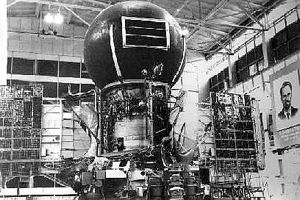 | Venera 9 Orbiter Credit: NASA |
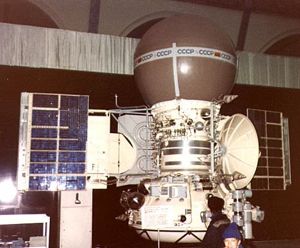 | Venera 10 / 4V-1 Credit: © Mark Wade |
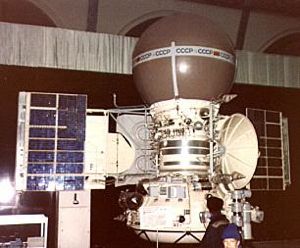 | Venera 10 Orbiter Venera 10 / 4V-1 Orbiter Credit: © Mark Wade |
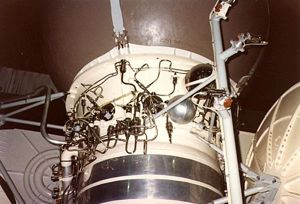 | Venera 10 Detail Venera 10 / 4V-1 Details Credit: © Mark Wade |
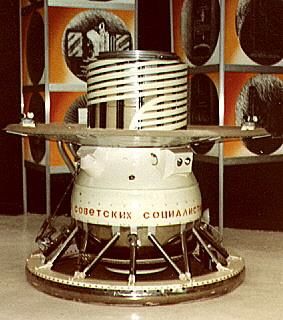 | Venera 10 Lander Venera 10 / 4V-1 lander Credit: © Mark Wade |
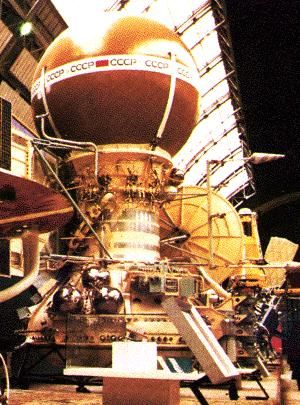 | Venera 13 Credit: NASA |
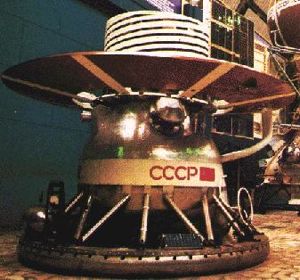 | Venera 13 Lander Credit: NASA |
 | Venera 9 Credit: Manufacturer Image |
1975 June 8 - . 02:38 GMT - . Launch Site: Baikonur. Launch Complex: Baikonur LC81/24. LV Family: Proton. Launch Vehicle: Proton-K/D.
- Venera 9 - .
Payload: 4V-1 s/n 660. Mass: 4,936 kg (10,882 lb). Nation: Russia.
Agency: MOM.
Program: Venera.
Class: Venus.
Type: Venus probe. Spacecraft Bus: 4MV.
Spacecraft: Venera 4V-1.
USAF Sat Cat: 7915 . COSPAR: 1975-050A. Apogee: 112,200 km (69,700 mi). Perigee: 1,510 km (930 mi). Inclination: 34.15 deg. Period: 2,898.00 min.
Combined Venus orbiter/lander mission. After separation of the lander, the orbiter spacecraft entered Venus orbit and acted as a communications relay for the lander and explored cloud layers and atmospheric parameters. On October 20, 1975, the Descent Craft was separated from the Orbiter, and landing was made with the sun near zenith at 05:13 GMT on October 22. The Descent Craft included a system of circulating fluid to distribute the heat load. This system, plus precooling prior to entry, permitted operation of the spacecraft for 53 min after landing. The landing was about 2,200 km from the Venera 10 landing site. Preliminary results indicated: (A) clouds 30-40 km thick with bases at 30-35 km altitude, (B) atmospheric constituents including HCl, HF, Br, and I, (C) surface pressure about 90 (earth) atmospheres, (D) surface temperature 485 deg C, (E) light levels comparable to those at earth midlatitudes on a cloudy summer day, and (F) successful TV photography showing shadows, no apparent dust in the air, and a variety of 30-40 cm rocks which were not eroded. Venera 9 and 10 were the first probes to send back black and white pictures from the Venusian surface. They were supposed to make 360 degree panoramic shots, but on both landers one of two camera covers failed to come off, restricting their field of view to 180 degrees. Parameters are for Venus orbit.
1975 June 14 - .
- Venera 10, Venus Landing - . Nation: Russia. Spacecraft Bus: 4MV. Spacecraft: Venera 4V-1.
1975 June 14 - . 03:00 GMT - . Launch Site: Baikonur. Launch Complex: Baikonur LC81/24. LV Family: Proton. Launch Vehicle: Proton-K/D.
- Venera 10 - .
Payload: 4V-1 s/n 661. Mass: 5,033 kg (11,095 lb). Nation: Russia.
Agency: MOM.
Program: Venera.
Class: Venus.
Type: Venus probe. Spacecraft Bus: 4MV.
Spacecraft: Venera 4V-1.
USAF Sat Cat: 7947 . COSPAR: 1975-054A. Apogee: 113,900 km (70,700 mi). Perigee: 1,620 km (1,000 mi). Inclination: 29.50 deg. Period: 2,963.00 min.
The orbiter spacecraft entered Venus orbit and was separated from the lander on October 23, 1975. The lander touched down with the sun near zenith, at 05:17 GMT, on October 25. A system of circulating fluid was used to distribute the heat load. This system, plus precooling prior to entry, permitted operation of the spacecraft for 65 min after landing. During descent, heat dissipation and deceleration were accomplished sequentially by protective hemispheric shells, three parachutes, a disk-shaped drag brake, and a compressible, metal, doughnut-shaped, landing cushion. The landing was about 2,200 km distant from Venera 9. Preliminary results provided: (A) profile of altitude (km)/pressure (earth atmospheres) / temperature (deg C) of 42/3.3/158, 15/37/363, and 0/92/465, (B) successful TV photography showing large pancake rocks with lava or other weathered rocks in between, and (C) surface wind speed of 3.5 m/s. Venera 9 and 10 were the first probes to send back black and white pictures from the Venusian surface. They were supposed to make 360 degree panoramic shots, but on both landers one of two camera covers failed to come off, restricting their field of view to 180 degrees.
1975 October 22 - .
- Venera 9, Venus Landing (Soviet Venus Orbiter/Lander) - . Nation: Russia. Spacecraft Bus: 4MV. Spacecraft: Venera 4V-1.
1975 October 25 - .
- Venera 10, Venus Landing - . Nation: Russia. Spacecraft Bus: 4MV. Spacecraft: Venera 4V-1.
1978 September 9 - . 03:25 GMT - . Launch Site: Baikonur. Launch Complex: Baikonur LC81/23. LV Family: Proton. Launch Vehicle: Proton-K/D-1.
- Venera 11 - .
Payload: 4V-1 s/n 360. Mass: 4,715 kg (10,394 lb). Nation: Russia.
Agency: MOM.
Program: Venera.
Class: Venus.
Type: Venus probe. Spacecraft Bus: 4MV.
Spacecraft: Venera 4V-1.
USAF Sat Cat: 11020 . COSPAR: 1978-084A.
Venera 11 was part of a two-spacecraft mission to study Venus and the interplanetary medium. Each of the two spacecraft, Venera 11 and Venera 12, consisted of a flight platform and a lander probe. Identical instruments were carried on both spacecraft. Venera 11 was launched into a 177 x 205 km, 51.5 degree inclination earth orbit from which it was propelled into a 3.5 month Venus transfer orbit. After ejection of the lander probe, the flight platform continued on past Venus in a heliocentric orbit. Near encounter with Venus occurred on December 25, 1978, at approximately 34,000 km altitude. The flight platform acted as a data relay for the descent craft for 95 minutes until it flew out of range and returned its own measurements on interplanetary space. The Venera 11 descent craft separated from its flight platform on December 23, 1978 and entered the Venus atmosphere two days later at 11.2 km/sec. During the descent, it employed aerodynamic braking followed by parachute braking and ending with atmospheric braking. It made a soft landing on the surface at 06:24 Moscow time on 25 December after a descent time of approximately 1 hour. The touchdown speed was 7-8 m/s.
Both Venera 11 and 12 landers failed to return colour television views of the surface and perform soil analysis experiments. All of the camera protective covers failed to eject after landing (the cause was not established) The soil drilling experiment was apparently damaged by a leak in the soil collection device, the interior of which was exposed to the high Venusian atmospheric pressure. The leak had probably formed during the descent phase because the lander was less aerodynamically stable than had been thought.
Two further experiments on the lander failed as well. Results reported included evidence of lightning and thunder, a high Ar36/Ar40 ratio, and the discovery of carbon monoxide at low altitudes.
1978 September 14 - . 02:25 GMT - . Launch Site: Baikonur. Launch Complex: Baikonur LC81/24. LV Family: Proton. Launch Vehicle: Proton-K/D-1.
- Venera 12 - .
Payload: 4V-1 s/n 361. Mass: 4,715 kg (10,394 lb). Nation: Russia.
Agency: MOM.
Program: Venera.
Class: Venus.
Type: Venus probe. Spacecraft Bus: 4MV.
Spacecraft: Venera 4V-1.
USAF Sat Cat: 11025 . COSPAR: 1978-086A.
Venera 12 was part of a two-spacecraft mission to study Venus and the interplanetary medium. Each of the two spacecraft, Venera 11 and Venera 12, consisted of a flight platform and a lander probe. Identical instruments were carried on both spacecraft. Venera 12 was launched into a 177 x 205 km, 51.5 degree inclination Earth orbit from which it was propelled into a 3.5 month Venus transfer orbit which involved two mid-course corrections, on 21 September and 14 December. After ejection of the lander probe on 19 December, two days before encounter, the flight platform continued on past Venus in a heliocentric orbit. Near encounter with Venus occurred on December 21, 1978, at approximately 34,000 km altitude. The flight platform acted as a data relay for the descent craft for 110 minutes until it flew out of range and returned to its own measurements on interplanetary space. The Venera 12 descent craft entered the Venus atmosphere at 11.2 km/sec two days after separation from the flight bus. During the descent, it employed aerodynamic braking followed by parachute braking and ending with atmospheric braking. It made a soft landing on the surface at 06:30 Moscow time on 21 December after a descent time of approximately 1 hour. The touchdown speed was 7-8 m/s.
Both Venera 11 and 12 landers failed to return colour television views of the surface and perform soil analysis experiments. All of the camera protective covers failed to eject after landing (the cause was not established) The soil drilling experiment was apparently damaged by a leak in the soil collection device, the interior of which was exposed to the high Venusian atmospheric pressure. The leak had probably formed during the descent phase because the lander was less aerodynamically stable than had been thought. Therefore the landing gear of the following two landers (Venera-13/14) were equipped with tooth-shaped stabilisers.
Results reported included evidence of lightning and thunder, a high Ar36/Ar40 ratio, and the discovery of carbon monoxide at low altitudes.
The Venera-12 flyby bus continued in solar orbit and successfully used its Soviet-French ultraviolet spectrometer to study Comet Bradfield on 13 February 1980 (one year and two months after its Venus encounter). At that time the spacecraft was 190,373,790 km from Earth.
1978 December 21 - .
- Venera 12, Venus Landing - . Nation: Russia. Spacecraft Bus: 4MV. Spacecraft: Venera 4V-1.
1978 December 25 - .
- Venera 11, Venus Landing - . Nation: Russia. Spacecraft Bus: 4MV. Spacecraft: Venera 4V-1.
1981 October 30 - . 06:04 GMT - . Launch Site: Baikonur. Launch Complex: Baikonur LC200/40. LV Family: Proton. Launch Vehicle: Proton-K/D-1.
- Venera 13 - .
Payload: 4V-1 s/n 760. Mass: 4,500 kg (9,900 lb). Nation: Russia.
Agency: MOM.
Program: Venera.
Class: Venus.
Type: Venus probe. Spacecraft Bus: 4MV.
Spacecraft: Venera 4V-1.
USAF Sat Cat: 12927 . COSPAR: 1981-106A.
Venera 13 and 14 were identical spacecraft built to take advantage of the 1981 Venus launch opportunity and launched 5 days apart. After launch and a four month cruise to Venus, the descent vehicle separated and plunged into the Venus atmosphere on 1 March 1982. As it flew by Venus the bus acted as a data relay for the brief life of the descent vehicle, and then continued on into a heliocentric orbit. After the descent vehicle braked to subsonic speed a parachute was deployed. At an altitude of 47 km the parachute was released and simple airbraking was used the rest of the way to the surface. Venera 13 landed about 950 km northeast of Venera 14 at 7 deg 30 min S, 303 E, just east of the eastern extension of an elevated region known as Phoebe Regio. The area was composed of bedrock outcrops surrounded by dark, fine-grained soil. After landing an imaging panorama was started and a mechanical drilling arm reached to the surface and obtained a sample, which was deposited in a hermetically sealed chamber, maintained at 30 degrees C and a pressure of about .05 atmospheres. The composition of the sample, as determined by the X-ray flourescence spectrometer, put it in the class of weakly differentiated melanocratic alkaline gabbroids. The lander survived for 127 minutes (the planned design life was 32 minutes) in an environment with a temperature of 457 degrees C and a pressure of 84 Earth atmospheres. The bus carried instruments built by Austrian and French specialists, as well as Soviet scientific equipment.
1981 November 4 - . 05:31 GMT - . Launch Site: Baikonur. Launch Complex: Baikonur LC200/39. LV Family: Proton. Launch Vehicle: Proton-K/D-1.
- Venera 14 - .
Payload: 4V-1 s/n 761. Mass: 4,000 kg (8,800 lb). Nation: Russia.
Agency: MOM.
Program: Venera.
Class: Venus.
Type: Venus probe. Spacecraft Bus: 4MV.
Spacecraft: Venera 4V-1.
USAF Sat Cat: 12938 . COSPAR: 1981-110A.
Venera 13 and 14 were identical spacecraft built to take advantage of the 1981 Venus launch opportunity and launched 5 days apart. After launch and a four month cruise to Venus, the descent vehicle separated and plunged into the Venus atmosphere on 5 March 1982. As it flew by Venus the bus acted as a data relay for the brief life of the descent vehicle, and then continued on into a heliocentric orbit. The parachute of the descent vehicle opened after the lander reached subsonic speed. At an altitude of about 50 km the parachute was released and simple airbraking was used the rest of the way to the surface. Venera 14 landed about 950 km southwest of Venera 13 near the eastern flank of Phoebe Regio at 13 deg 15 min S by 310 E on a basaltic plain. After landing an imaging panorama was started It has been reported that the surface analysis arm accidentally landed on one of the ejected camera covers and therefore didn't send back any data on the Venusian soil. This is visible in photographs sent back. On the other hand, the official account very specifically states that the mechanical drilling arm obtained a sample, which was deposited in a hermetically sealed chamber, maintained at 30 degrees C and a pressure of about .05 atmospheres. The composition of the sample was determined by the X-ray flourescence spectrometer, showing it to be similar to oceanic tholeiitic basalts. The lander survived for 57 minutes (the planned design life was 32 minutes) in an environment with a temperature of 465 degrees C and a pressure of 94 Earth atmospheres.
1982 March 1 - .
- Venera 13 Venus Flyby/Landing - . Nation: Russia. Spacecraft Bus: 4MV. Spacecraft: Venera 4V-1.
1982 March 5 - .
- Venera 14 Venus Flyby/Landing - . Nation: Russia. Spacecraft Bus: 4MV. Spacecraft: Venera 4V-1.
Back to top of page
Home - Search - Browse - Alphabetic Index: 0- 1- 2- 3- 4- 5- 6- 7- 8- 9
A- B- C- D- E- F- G- H- I- J- K- L- M- N- O- P- Q- R- S- T- U- V- W- X- Y- Z
© 1997-2019 Mark Wade - Contact
© / Conditions for Use